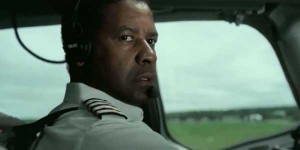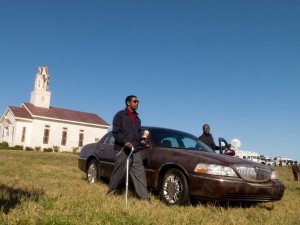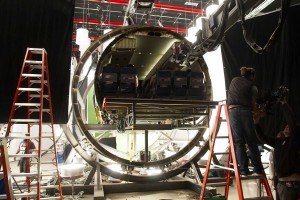
Production designer Nelson Coates has two films playing this holiday season – the Barbara Streisand/Seth Rogen comedy Road Trip, and the Denzel Washington film Flight. It’s the latter film, with its recreated plane interiors, palpable regional feel and multi-generational character layers in the sets, that’s creating the biggest buzz for Coates this award season, perhaps because the film is anchored to such a powerful performance from Washington. He plays the Atlanta-based pilot whose initial heroics in landing a failing aircraft turn into an investigation – or witch hunt – forcing him to confront long ignored demons of his own.
According to Coates, the film was shot entirely where it was set. And that setting is the American southeast, primarily Atlanta and environs. Coates also said that the fact that Atlanta is a “production center” helped.
In the film, Washington’s character, Whip Whitaker, had learned to fly from his father, the crop-duster. Coates explained that they wanted a sense that many generations had been there in the city and in the dwellings where the characters live, particularly an inherited farm to which Whitaker retreats when the investigation starts to get heavy. The generational touches at the house are subtle – a flatscreen TV atop an older color set in its own freestanding cabinet, a cassette player and wall-mounted phone, etc.

Outside, the script called for a grass runway. But there were only four grass airstrips within an hour radius of Atlanta. So they found the runway they wanted with a great barn alongside, and decided they would just build the farm house next to it. This allowed director Robert Zemeckis – working in live action for the first time in nearly a decade, and with Coates for the first time – to get some of the specific views he wanted to see out the doors and out the windows, which meant they oriented the house a specific way on the property. And built it in non-traditional ways as well. “The house we built on site is 20 percent bigger than the house we built on stage,” Coates explained. Those stages were converted warehouses that also included production offices. But the larger exteriors were so “it wouldn’t read like a postage stamp on the field” where they were shooting.

Similarly, for another critical sequence where the crippled plane is being brought into an open field, there needed to be a church steeple for a wing to clip on the way down. “We thought we’d be able to find a church,” Coates said, but the Atlanta area is all very wooded, until you head to that proverbial hour out of town. So, as with the ranch, the production company wound up building its own church as well.
The company also built a lake – or perhaps “dug” is a better term – nearby, so that witnesses to the crash would be available during a Baptism ceremony being held outside. Building their own steeple once again allowed Zemeckis to begin considering the geometry of the situation. “We came in and executed,” Coates said. This execution included calculating how tall the steeple needed to be to catch the angle of descent of the plane (which would be green-screened later), as well as the distance to the lake.

As for the plane, that had to be designed so that it wasn’t a specific brand or type, but rather “an amalgam of different manufacturers.” Coates and his team took pieces of three different manufacturers to create a fictional model of aircraft. This went along with a fictional airstrip they had to build south of Atlanta’s airport. Atlanta’s runway was fully functional, but the company found that Atlanta’s airport didn’t have a section set up, as LAX does, to routinely accommodate filmmakers.
Coates was clearly excited to talk about all of the thought that went into the film, including the way they had to arrange to shoot in interior sections of the plane, created at Screen Gems’ facility, also in Atlanta – using one section as the rear of the plane, getting all the scenes, then retrofitting it to become the “middle,” and later the forward cabin. There were successful scouts for under-the-flightway apartments, fictional hotel rooms for sequestered witnesses, and much more.
But all of it needed “to be as carefully crafted as a costume drama,” since Flight is something rare – an R-rated character study, whose main story really isn’t about the crash, or any other outsized mechanical or FX-generated drama, but simply the story of a man, caught up in events, who must come to a fateful decision.
Coates said he “was very tickled to get to work on something with so many layers on it.” Happily for audiences, those layers are evident on the screen.




